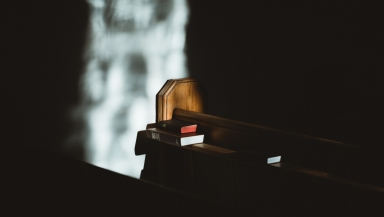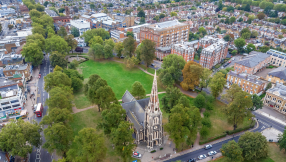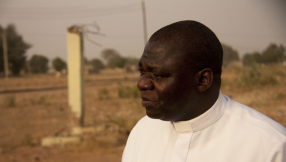
On 13 August, the vicar of St Bartholomew's the Great launched a campaign to wrest power away from Archbishop Welby's entourage.
Writing in The Times, he started a campaign to persuade candidates to stand in the imminent General Synod elections under the 'Save the Parish' banner.
The eighteenth century saw the birth of Evangelical revivals with the Wesley brothers and George Whitefield. The nineteenth century birthed the failed attempt to borrow Roman Catholic spirituality from the mother church and see if it could be reconciled with the fiercely anti-Catholic 39 articles. The twentieth century saw an aggressively reductionist liberalisation of the faith (driven by the German theologians and scientific materialism), followed by an unexpected outburst of charismatic fervour.
Will history remember the Rev Marcus Walker as the pioneer leader of a new Anglican political movement, energised to reclaim political power from the Archbishop's greatly expanded secretariat at the beginning of the twenty first century?
Whatever the outcome, the 'Save the Parish' movement represents an attempt at a real challenge to the paradoxically contradictory liberal/evangelical theological reflexes of the Welby regime.
In a previous article I described the excited announcement that the plan was to create 10,000 new church communities in ten years as 'fantasy theology'. I was not alone in questioning the assumptions that lay behind the plan.
Other critics asked whether these lay communities had anything Anglican about them.
Where were the priests; where was the eucharist; where were the holy spaces; where was the historical continuity? Since these are all characteristics of the Catholic inheritance that the C of E has uneasily but pragmatically incorporated, it may be that this energetic flourish represents a last-ditch impatient assertion of Protestant informality; a final repudiation of the Anglican attempt to mix the best of Catholic and Reformed spirituality.
Perhaps Welbyism, facing the fear that the demographics of the Church give it only another 10 years of life, has gone the full informal, evangelical Monty. It has resorted as a last gasp to what it thinks it knows best.
Evangelical Anglicanism has resentfully put up with its Roman Catholic inheritance - the medieval inspiration that sculpted enormous crosses out of stone and built exquisite vaults stretching to heaven; it has resented and quibbled over theologies of orders; it has endured the historical (dis)continuity with a muddled 500 years of contested history; it has resented the shackling of the bread and wine with the memory of the Mass. And in a last-ditch attempt to ditch an ill-fitting suit of clothes it has placed all its chips on the roulette square of lay-led church planting.
Was the description of fantasy theology too harsh? Over my 35 years as an Anglican clergyman I had seen a rich and wide variety of attempts to fire up Church renewal. David Watson in the 1970s, John Wimber in the 1980s, the Mega house church movement of the 1990s to name only a few.
In response to my earlier analysis of the 10,000 in 10 years plan, I was contacted by a friend of mine who had been heavily involved as a Vineyard Church planter of some repute, who confirmed that from his experience this much vaunted expectation of 10,000 new lay led churches in 10 years was indeed fantasy theology.
Inspired by the highly successful and impressive John Wimber, the Vineyard church set out to plant churches in the UK beginning in about 1988. It began, much as the Welby vision suggests with some highly committed lay leaders meeting in their homes. Over the last 32 years, it has planted and sustained 130 churches.
The cost in human sacrifice has been considerable. One retrospective study of 14 of the most successful lay leaders documented serious attrition amongst people who had worked intensely hard and made very serious sacrifices.
There was a high initial failure rate; many of the early plants just fizzled out. Where they succeeded there were serious costs involved; chronic physical illness, the fracturing of marriages, and even the surprise of premature deaths. The pattern of lay led church planting in homes followed the usual evolutionary growth of church groups that began with small committed nucleal.
Front rooms grew into rented halls and these grew into bought buildings. Throwing money at church planting proved counterproductive. Instead sophisticated national and international training programmes were introduced to direct strategy and energy. These are the very things that the Welby plan gleefully promises to abolish as destructively expensive 'key limiting factors'.
The analysis from those who had succeeded in planting 130 churches over 30 years is that the Welby rhetoric of selling his plan of 10,000 churches over 10 years over is "complete nonsense and dangerously ignorant." 'Fantasy theology' was thought to be a little too polite.
Anglicanism as an expression of Christianity has aspired over the last 500 years to be the best of a mixture of Christian cultures. At times it has succeeded impressively and carried the Gospel around the world to great effect. The lack of agreement about what it actually was, was sometimes used to competitively productive effect.
The situation the Christian West faces in the coming decades is becoming a stark one. The challenge will involve finding the courage and clarity to continue to keep its integrity and witness in the face of increasingly hostile secularism. This energised hostility is showing a growing willingness to suppress and persecute Christians. The Church has seen such cultural shifts before and although it has had to pay the highest of prices, it has endured and outlasted them.
This will take heroic courage and tested integrity. The lesson of history is that the churches that have survived and come through have been ones that were very clear not only about what they stood for, but also where they had come from historically.
The dark clouds in the cultural and political horizon call for a more coherent ecclesiology and informed strategy than untested high octane optimistic brain-storming.
'Saving the Parishes' may require more than a polite tiff seeking a bit of extra leverage in a church synod. The Church of England was born out of a cultural upheaval and secular political crisis. It must hope and pray that it develops a sufficient clarity about its own strategy and identity to avoid succumbing to the hostility of this latest cultural confrontation and politicised anti-Christian aggression.
Dr Gavin Ashenden is a former chaplain to the Queen. He blogs at Ashenden.org













